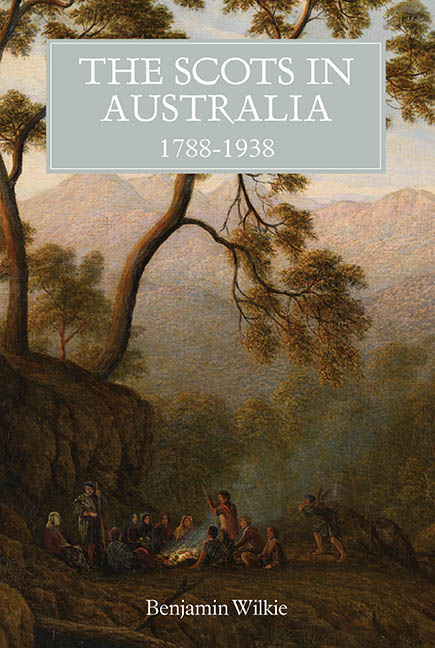Book contents
- Frontmatter
- Contents
- Illustrations
- Acknowledgements
- Abbreviations
- Introduction
- 1 From Scotland to Australia: Convicts, Free Settlers, and Encounters with Australia
- 2 Caledonia Australis: Imperial Commerce, Migrant Networks, and Australian Pastoralism
- 3 Scottish Migrants and Indigenous Australians
- 4 Imagining Home: Scottish Culture in Australia
- 5 Warriors of Empire: A Case Study of Popular Imperialism
- 6 The Empire Builders: Imperial Commerce and Migration between the Wars
- 7 New Scots: Industry, Settlement, and Working-Class Migration
- 8 At The Edge of Scotland's Diaspora: Diversity and Tension in the Twentieth Century
- Conclusion: The Imperial Legacy
- Bibliography
- Index
- Frontmatter
- Contents
- Illustrations
- Acknowledgements
- Abbreviations
- Introduction
- 1 From Scotland to Australia: Convicts, Free Settlers, and Encounters with Australia
- 2 Caledonia Australis: Imperial Commerce, Migrant Networks, and Australian Pastoralism
- 3 Scottish Migrants and Indigenous Australians
- 4 Imagining Home: Scottish Culture in Australia
- 5 Warriors of Empire: A Case Study of Popular Imperialism
- 6 The Empire Builders: Imperial Commerce and Migration between the Wars
- 7 New Scots: Industry, Settlement, and Working-Class Migration
- 8 At The Edge of Scotland's Diaspora: Diversity and Tension in the Twentieth Century
- Conclusion: The Imperial Legacy
- Bibliography
- Index
Summary
In 1896, Alice MacDonell, a poet from Keppoch in Scotland, wrote ‘The weaving of the tartan’. The short poem relates the story of an old woman while she sits and weaves a tartan; as she works, the ‘Old Dame’ explains to the narrator the meaning of each colour and thread: ‘She wove in red for every deed, / Of valour done for Scotia's need: / She wove in green, the laurel's sheen, / In memory of her glorious dead.’ The old woman stresses the importance of each weft and warp she makes: ‘And warp well the long threads, / The bright threads, the strong threads; / Woof well the cross threads, / To make the colours shine.’ The weaving of the tartan becomes the creation of an identity, or narrative, each thread and colour symbolic of the many elements that go together to make up Scotland and Scottishness, each weft and warp representing the ways in which these experiences interact and create new meanings.
MacDonell has selected an apt symbol, for the tartan itself is the embodiment of an ongoing tension between the inflexibility of its grid and pattern, and the never-ending possibilities for colour and variety – the array of human experience, and the rules and boundaries of culture and identities. Weaving a ‘web of tartan fine’, the Old Dame of MacDonell's poem carefully selects and intertwines the various strands of Scottish experience into a design that is at once ordered and organic, a multiplicity of narratives and meanings woven into a rigidly patterned but vibrantly coloured design.
This is a book about the many experiences of the Scots in Australia, from the first colonists in the late eighteenth century until the hopeful arrivals of the interwar years. It is about how and why they migrated to Australia, and their experiences as convicts, colonists, farmers, families, workers, and weavers of culture and identity. It explores their encounters with the Australian continent, whether in its cities or on the land, and their relationship with its First Peoples. This book interro¬gates their connections to one another and with their own collective identities, and examines diversity and tension within the Scottish diaspora in Australia. It is also a book about the challenges of finding a place for oneself in a new land, and the difficulties of creating a sense of belonging in a settler colonial society.
- Type
- Chapter
- Information
- The Scots in Australia, 1788–1938 , pp. 1 - 12Publisher: Boydell & BrewerPrint publication year: 2017

